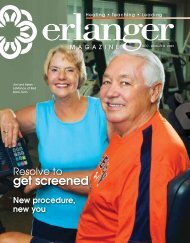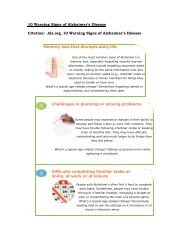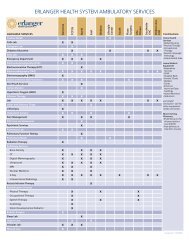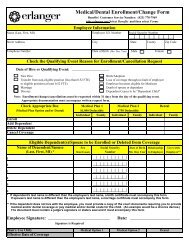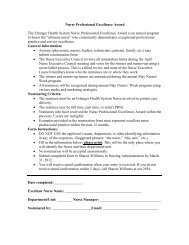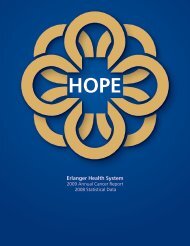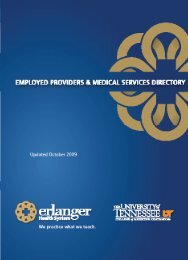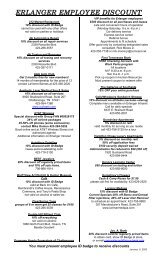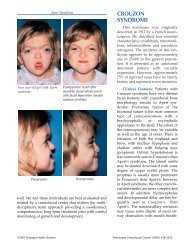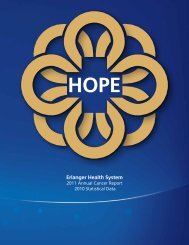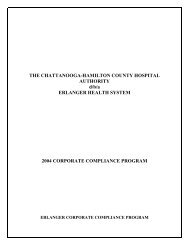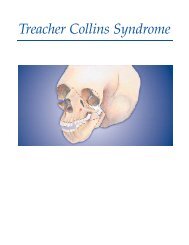EOC - Erlanger Health System
EOC - Erlanger Health System
EOC - Erlanger Health System
You also want an ePaper? Increase the reach of your titles
YUMPU automatically turns print PDFs into web optimized ePapers that Google loves.
You are required to pay directly to a<br />
Provider for certain Covered Services. You<br />
must pay such Copayments at the time You<br />
receive those Services.<br />
15. Cosmetic Surgery – Any treatment intended<br />
to improve Your appearance. Our Medical<br />
Policy establishes the criteria for what is<br />
cosmetic, and what is Medically Necessary<br />
and Appropriate.<br />
16. Covered Dependent – A Subscriber’s<br />
family member who: (1) meets the eligibility<br />
requirements of this <strong>EOC</strong>; (2) has been<br />
enrolled for Coverage; and (3) for whom the<br />
Plan has received the applicable Payment for<br />
Coverage.<br />
17. Covered Family Members – A Subscriber<br />
and his or her Covered Dependents.<br />
18. Covered Services, Coverage or Covered –<br />
Those Medically Necessary and Appropriate<br />
services and supplies that are set forth in<br />
Attachment A of this <strong>EOC</strong>, (which is<br />
incorporated by reference). Covered<br />
Services are subject to all the terms,<br />
conditions, exclusions and limitations of the<br />
Plan and this <strong>EOC</strong>.<br />
19. Creditable Coverage – Credit for Your<br />
individual or group health coverage prior to<br />
Your Enrollment Date that may be applied to<br />
reduce Your Pre-existing Condition Waiting<br />
Period, if any, stated in this <strong>EOC</strong>. Creditable<br />
Coverage also includes coverage under: (1)<br />
a group health plan; (2) health insurance<br />
coverage; (3) health maintenance<br />
organization (HMO); (4) Medicare; (5)<br />
Medicaid (including TennCare SM and<br />
TennCare Select SM ); (6) COBRA<br />
continuation and state continuation; (7) the<br />
Federal Employee <strong>Health</strong> Benefit Plan; (8) a<br />
public, government, military or Indian<br />
<strong>Health</strong> Service health benefit program;<br />
and/or (9) State Children’s <strong>Health</strong> Insurance<br />
Program (S-CHIP).<br />
Up to 18 months of Creditable Coverage may<br />
be applied to reduce Your applicable Preexisting<br />
Condition Waiting Period.<br />
However, a period of coverage will not be<br />
counted for purposes of reducing Your Preexisting<br />
Condition Waiting Period if there is<br />
a break in such coverage of 63 days or more<br />
during which You were not Covered under<br />
any Creditable Coverage.<br />
20. Custodial Care – Any services or supplies<br />
provided to assist an individual in the<br />
activities of daily living as determined by the<br />
Plan including but not limited to eating,<br />
bathing, dressing or other self-care activities.<br />
21. Deductible – The dollar amount, specified in<br />
Attachment C, Schedule of Benefits, that<br />
You must incur and pay for Covered<br />
Services during a Calendar Year before the<br />
Plan provides benefits for services. There<br />
are 2 separate Deductible amounts – one for<br />
Network Providers and one for Out-of-<br />
Network Providers. Satisfying the<br />
Deductible under the Network Provider<br />
benefits does not satisfy the Deductible for<br />
the Out-of-Network Provider benefits, and<br />
vice versa; the two Deductibles are not<br />
combined. Dollar amounts incurred during<br />
the last 3 months of a Calendar Year that are<br />
applied to the Deductible during that<br />
Calendar Year will also apply to the<br />
Deductible but not the Out-of-Pocket<br />
Maximum for the next Calendar Year. The<br />
Deductible will apply to the Individual Outof-Pocket<br />
and Family Out-of-Pocket<br />
Maximum(s).<br />
Copayments and any balance of charges (the<br />
difference between Billed Charges and the<br />
Maximum Allowable Charge) are not<br />
considered when determining if You have<br />
satisfied a Deductible.<br />
22. Emergency – A sudden and unexpected<br />
medical condition that manifests itself by<br />
symptoms of sufficient severity, including<br />
severe pain, that a prudent layperson, who<br />
possesses an average knowledge of health<br />
and medicine could reasonably expect to<br />
result in:<br />
a. serious impairment of bodily functions;<br />
or<br />
b. serious dysfunction of any bodily organ<br />
or part; or<br />
c. placing a prudent layperson’s health in<br />
serious jeopardy.<br />
Examples of Emergency conditions include:<br />
(1) severe chest pain; (2) uncontrollable<br />
bleeding; or (3) unconsciousness.<br />
23. Emergency Care Services – Those services<br />
and supplies that are Medically Necessary<br />
and Appropriate in the treatment of an<br />
Emergency.<br />
28 <strong>Erlanger</strong> <strong>Health</strong> <strong>System</strong> 2009




